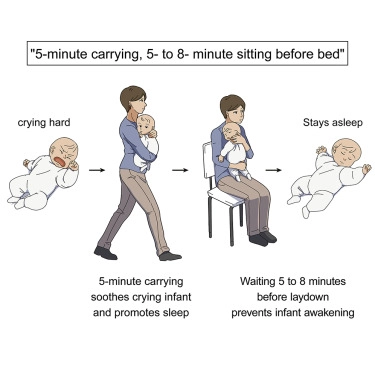How to put a baby to sleep: a new approach backed by science
How to put a baby to sleep is one of the most asked questions in our mobile app LactApp. Today we can report on a brand new scientific study that proposes a step-by-step method for putting a baby to sleep and leaving them in their cot without waking them up.
It is hard to accept that babies have different sleep patterns than adults and have different needs than adults. Their first and most important need: contact at all times, yes, even during sleep. It is very common for adults to think that babies have a hard time falling asleep and when they are sleepy or overtired, they may cry a lot and be very restless.
This situation causes a lot of frustration and stress in families and raises many questions about how to put a baby to sleep. There is a lot of talk nowadays about sleep training methods, but there is also more and more knowledge about the physiology of babies’ sleep. And yet, families are still looking for solutions and ways to get their little one to sleep more easily and in less time.
What does this study propose?
Today we highlight a new scientific study that proposes a method to help to calm and put babies to sleep without the need to let them cry.
The method they have researched is based on 3 steps:
- The adult holds the baby in her/his arms and walks around for 5 minutes to calm the baby and help her fall asleep.
- Then the adult sits with the sleeping baby in her arms for 5-8 minutes.
- And finally, the baby is transferred to the cot or bed.

How did they come to this conclusion?
To develop this method, the researchers studied different ways of putting babies to sleep: in the arms, in motion, in arms with the adult sitting up, in a moving pram and in the cot or bed. They measured how long it took for the babies to fall asleep in these ways and monitored the babies’ behaviour and physiology using electrocardiograms and recorded the entire experiment on video.
From the results, they concluded that the ideal combination of walking the baby for 5 minutes and holding the sleeping baby in their arms for 5-8 minutes helped the babies fall asleep for longer.
What did they discover?
According to the study, walking babies activates the vagal response (which causes a slowing of the heartbeat and a drop in blood pressure) that helps babies to get calm when they are carried, and so they fall asleep more easily. According to the authors, this response is common among altricial mammals. This term refers to mammalian offspring that are born blind, with no open ear canals, virtually no hair or feathers and very limited mobility. In a way, human infants are like this, totally helpless and totally dependent on the care of the adult, which serves to help the mother carry their young in dangerous situations.
Once the babies are asleep, if they are left directly in the cot, crib or bed, they notice the separation from the mother and become active. This is why this method suggests sitting with the sleeping baby in the arms for an additional 5-8 minutes, as it allows the baby to pass from phase I sleep, which is light sleep and enter the following phase of sleep. Once fully asleep, the baby can be moved to the cot or bed more easily. We are sure this sounds familiar to many of you!
However, consider that this study has been carried out with only a very limited number of families (21 participating families), so the results may be inaccurate and therefore this method may not work for all families or babies. But despite this, it is very positive that research is being carried out into methods for accompanying babies to sleep in a respectful way, moving away from methods that propose to leave babies to cry on their own.